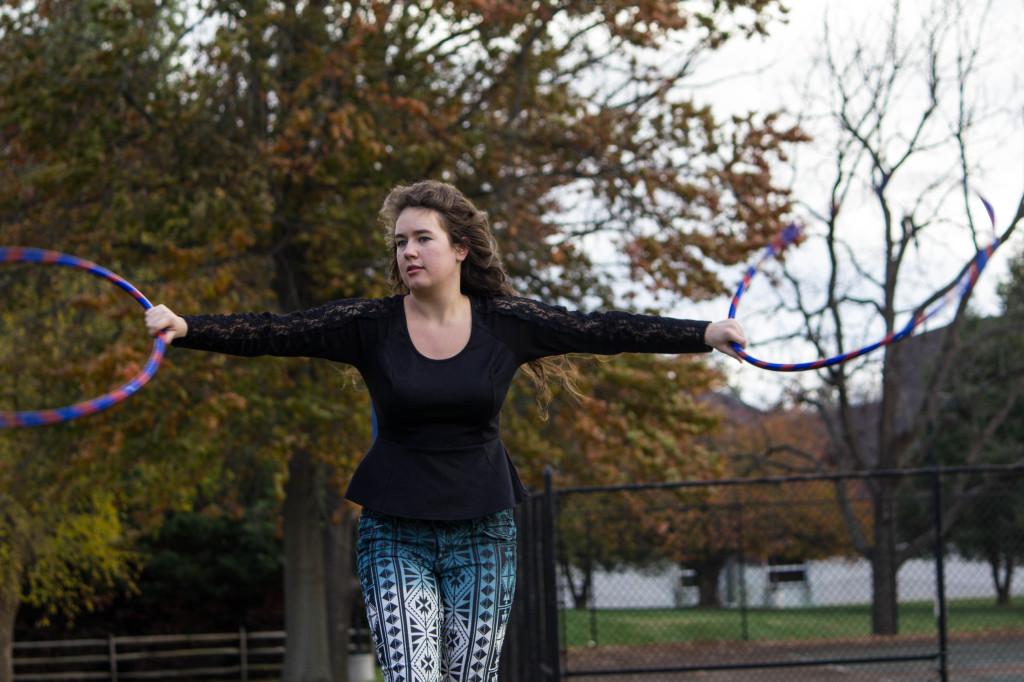A woman recently stood atop a van in F lot on the west side of Shepherd University spinning a hula hoop around her body.
Below her circled her friends and the owner of the vehicle who had just handed over $900 for the ride. “I just thought that was glorious,” said Daisy Thomas, an English and creative writing major. “So I said, ‘I need to christen this thing by just hooping on top of it.’ So I did.”
Thomas is a part of a subculture phenomenon called hoop dancing, or hooping. She is often seen spinning away and doing hoop tricks outside of Burkhart Hall.
Thomas discovered hooping last April at the Bonnaroo Music Festival. “I noticed a lot of the hoopers had very ballet-like movements and were incorporating a lot of dance into their hooping tricks,” she said. “I said ‘Wow, I could totally do that.’ I’ve been hooping ever since. I picked up one of my mom’s exercise hoops and went from there.”
Thomas classically trained in dance at Charleston Ballet for nine years, which is where she took inspiration for her hooping. She can perform many different forms of body hooping, including spinning around her waist, shoulders, neck, chest, and legs. She also knows more advanced tricks from elbow hooping to isolation spinning.
For the most part, Thomas taught herself to hoop dance by watching videos on the Internet. She also learned at various festivals from others who have been hooping for much longer.
Hooping is what is known as a flow art, or an art form that involves integrating dance, movement, and the manipulation of objects. Artists strive to get into “the flow” in which they do not have to think about what they are doing but instead just enjoy the act of moving. Other flow arts include juggling, fire-dancing, spinning wands and staffs, and spinning poi; poi are ropes with lights at the end that can be spun to make shapes, words and designs.
Many use hooping as a form of exercise, as it strengthens the core muscles around the waist and burns calories, but for others it is a far more spiritual experience.
According to Thomas, getting into the flow is extremely meditative. “It’s a really great way to center your energy by focusing on an object and making it part of your own movement and putting your own style to it,” she said. Hooping can be a different experience for everyone who tries it. Some prefer to dance to music, others do not. Hoopers enjoy customizing their hoops by size, weight, color, and even using lighted hoops, as Thomas often does at night. There are many different variations, Thomas explained, making hoop dancing a very personal form of art.
Thomas said she would recommend hooping to anyone who may be interested in trying something new. There is no club or group for hoopers on campus, but interested potential hoopers can find infinite tutorials and information about the practice online, and Thomas is also around to ask for pointers. “I just have a thing for constantly moving and doing interesting things with my movement,” she said happily.
From simple body hooping to LED hoop displays and fire hooping, this dance practice is one for all levels of ability. According to hooping.org, hooping is unlike regular children’s hula hooping because of the larger, heavier hoops. It has become extremely popular at concerts and various music festivals since the mid 1990s, especially when a band called The String Cheese Incident began tossing hoops into the audience at their concerts.
The hooping pastime is now spreading out from the concerts of its origin to the daily lives of many people around the country.
